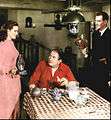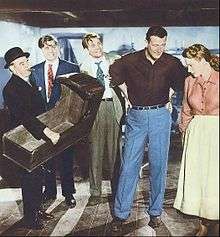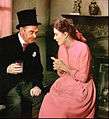The Quiet Man
| The Quiet Man | |
|---|---|
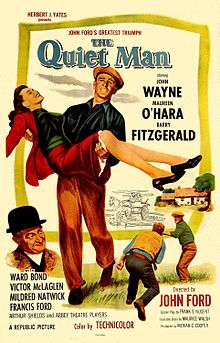 Theatrical release poster | |
| Directed by | John Ford |
| Produced by |
John Ford Merian C. Cooper |
| Screenplay by | Frank S. Nugent |
| Based on |
The Quiet Man 1933 story in The Saturday Evening Post by Maurice Walsh |
| Starring |
John Wayne Maureen O'Hara Barry Fitzgerald Ward Bond Victor McLaglen |
| Narrated by | Ward Bond |
| Music by | Victor Young |
| Cinematography | Winton C. Hoch |
| Edited by | Jack Murray |
Production company | |
| Distributed by | Republic Pictures |
Release date |
June 6, 1952 (London and Dublin)[1] August 21, 1952 (New York) |
Running time | 129 minutes |
| Country | United States |
| Language | English, Irish |
| Budget | $1.75 million |
| Box office | $3.2 million (rentals)[2] |
The Quiet Man is a 1952 Technicolor American romantic comedy-drama film directed by John Ford. It stars John Wayne, Maureen O'Hara, Barry Fitzgerald, Ward Bond and Victor McLaglen. The screenplay by Frank S. Nugent was based on a 1933 Saturday Evening Post short story of the same name by Maurice Walsh, later published as part of a collection The Green Rushes. The film is notable for Winton Hoch's lush photography of the Irish countryside and a long, climactic, semi-comic fist fight. It was an official selection of the 1952 Venice Film Festival.
The Quiet Man won the Academy Award for Best Director for John Ford, his fourth, and for Best Cinematography. In 2013, the film was selected for preservation in the United States National Film Registry by the Library of Congress as being "culturally, historically, or aesthetically significant".[3]
Plot

In the 1920s, Sean Thornton (John Wayne), an Irish-born American from Pittsburgh, travels to Ireland to reclaim his family's farm and his birthplace in Inisfree. He meets and falls in love with the fiery Mary Kate Danaher (Maureen O'Hara), the sister of the bullying, loud-mouthed landowner Squire "Red" Will Danaher (Victor McLaglen). Danaher, who had wanted the farm himself, is angry that the Widow Tillane (angered by Danaher's admission that he had discussed her in the local pub) accepts Sean's bid, and retaliates by refusing consent for his sister to marry. Several town locals, including the Catholic priest, Father Lonergan (Ward Bond) and the village matchmaker (and bookmaker) Michaleen Oge Flynn (Barry Fitzgerald), conspire to trick him into believing that the wealthy Widow Tillane (Mildred Natwick) wants to marry him, but only if Mary Kate is no longer living in his house. After learning the truth on Sean and Mary Kate's wedding day, an enraged Will refuses to give his sister her dowry which is made up of a large sum of money and her family possessions passed down from her mother.
Sean, unschooled in Irish customs, cares nothing about the dowry, but to Mary Kate the dowry represents her independence, identity, and pride. She feels passionately and intensely that the dowry is hers and is needed to validate her marriage to Sean. Angered and shamed by Sean's refusal to confront her brother and demand what is legally hers, she brands him a coward, and, despite living together, they are estranged as husband and wife. In the morning they find that others in the village had visited Will and pressured him to return Mary Kate's furniture, but could not make him pay the 350 pounds of dowry money.
Sean had been a boxer in the United States, a heavyweight challenger known as "Trooper Thorn." After accidentally killing an opponent in the ring, Sean hung up his gloves, vowing never to fight again. This is known to only one person in the village, the Church of Ireland minister, the Rev. Playfair (Arthur Shields), who once upon a time had been the lightweight champion and so understands Thornton's internal conflict over the fight.

In an attempt to force Sean to confront Will, Mary Kate leaves him and boards a train departing Castletown and headed to Dublin. Sean hears from Michaleen that she left for the station and drags her off the train. Followed by a crowd of townspeople, he forces her to walk with him the five miles back to Inisfree and directly to the Danaher farm. Sean demands that Will hand over her dowry. When Will refuses, he throws Mary Kate back at Will, saying that "no dowry, no marriage" is their custom, not his; shocking the two and shaming Will into finally paying the monetary portion of his sister's dowry. Sean promptly throws the money into a nearby furnace which Mary Kate holds open, showing that Mary Kate never cared about the money but only what it represented.
After a proud Mary Kate announces so all can hear that she will now return home to prepare his supper and departs, Will throws a punch at Sean, and is dropped by Sean's vicious right hook to the gut. A long, memorable fistfight ensues between the two, drawing crowds from miles around. They slug it out through the village, stop for a drink, admit grudging mutual respect for each other, and disagree over who is to pay for the porter they are drinking. Sean ends the fight by clocking Danaher on the jaw hard enough to smash him through the pub's door, knocking him out. Then, somewhat drunk, the two return to Sean and Mary Kate's home for supper, where it is implied the rift is healed. Sean regains Mary Kate's love and respect.
In the aftermath it is shown that Will and the Widow Tillane begin courting, and "peace is returned to Inisfree". When last seen, Mary Kate has whispered something in Sean's ear and the couple is shown trotting back to their house ... in the middle of the day, no less.
Cast
- John Wayne as Sean Thornton
- Maureen O'Hara as Mary Kate Danaher
- Barry Fitzgerald as Michaeleen "Óge" Flynn (Óge means "young" in Irish, which was used to denote between a father and son named the same, such as "Sr." and "Jr." are used in English)
- Victor McLaglen as Squire "Red" Will Danaher
- Ward Bond as Father Peter Lonergan
- Mildred Natwick as the Widow Sarah Tillane
- Francis Ford as Dan Tobin
- Arthur Shields as Rev. Cyril Playfair
- Eileen Crowe as Elizabeth Playfair
- Charles FitzSimons as Hugh Forbes
- James Fitzsimons (as James Lilburn) as Father Paul
- Sean McClory as Owen Glynn
- Emily Eby as Mave Campbell
- Jack MacGowran as Ignatius Feeney
- Philip Stainton as Anglican Bishop
- May Craig as Fishwoman with Basket at Station
- Paddy O'Donnell as Railway porter
- Eric Gorman as Costello – Engine driver
- Kevin Lawless as Engine fireman
- Joseph O'Dea as Molouney – Train guard
- Tony Canzoneri as Boxing Second (uncredited)
- Frank Baker as Man in Bar (uncredited)
- Ruth Clifford as Mother (uncredited)
- Maureen Coyne as Dan Tobin's Daughter Ireland (uncredited)
- Mimi Doyle as Dan Tobin's Daughter USA (uncredited)
- Ken Curtis as Dermot Fahy (uncredited)
- Douglas Evans as Ring Physician (uncredited)
- Charles Ferguson as Danaher Brother (uncredited)
- Robert Foy as Driver of Cart Across River (uncredited)
- Sam Harris as the deaf General (uncredited)
- D.R.O. Hatswell as Guppy (uncredited)
- John Horan as Man at Railway Station (uncredited)
- David Hughes as Police Constable (uncredited)
- Billy Jones as Bugler (uncredited)
- Tiny Jones as Nell (Maid) (uncredited)
- Colin Kenny as Pub Extra (uncredited)
- Patrick Wayne as Boy on Wagon at Horse Race (uncredited)
- Michael Wayne as Teenage Boy at Races (uncredited)
- Toni Wayne as Teenage Girl at Races (uncredited)
- Melinda Wayne as Girl on Wagon at Horse Race (uncredited)
- Mae Marsh as Father Paul's Mother (uncredited)
- Jim Morrin as Roof Thatcher (uncredited)
- Jim McVeigh as Man Following Cart Across River (uncredited)
- Harry Tenbrook as Police Sergeant Hanan (uncredited)
- Harry Tyler as Pat Cohan (Publican) (uncredited)
- Al Murphy as Boxing Referee (uncredited)
- Hank Worden as Boxing Trainer (uncredited)
- Michael O'Brian as Musha Musha Man (uncredited)
- Pat O'Malley as Man in Bar (uncredited)
- Frank O'Connor as Ringside Photographer (uncredited)
- Web Overlander as Hugh Bailey (Stationmaster) (uncredited)
- Bob Perry as Trooper Thorn's Ringside Trainer (uncredited)
- Darla Ridgeway as Girl (uncredited)
- Freddy Ridgeway as Boy (uncredited)
- Philip Stainton as Anglican Bishop (uncredited)
- Jack Roper as Tony Gardello (Boxer) (uncredited)
- Brick Sullivan as Townsman (uncredited)
Production
The film was something of a departure for Wayne and Ford, who were both known mostly for Westerns and other action-oriented films. It was also a departure for Republic Pictures, which backed Ford in what was considered a risky venture at the time. It was the only time the studio, known for low budget B-movies, released a film that would receive an Oscar nomination for Best Picture.
Ford read the story in 1933 and soon purchased the rights to it for $10. The story's author was paid another $2,500 when Republic bought the idea, and he received a final payment of $3,750 when the film was actually made.[4] Republic Pictures agreed to finance the film with O'Hara and Wayne starring and Ford directing, but only if all three agreed to first film a Western with Republic. They did, and after completing Rio Grande, they headed for Ireland to start shooting.
One of the conditions that Republic placed on Ford was that the film run under two hours. However, the finished picture was two hours and nine minutes. When screening the film for Republic executives, Ford stopped the film at approximately two hours in, on the verge of the climactic fistfight. Republic executives relented and allowed the film to run its full length.[5] It was one of the few films that Republic filmed in Technicolor; most of the studio's other color films were made in a more economical process known as Trucolor.
The film employed many actors from the Irish theatre, including Barry Fitzgerald's brother, Arthur Shields, as well as extras from the Irish countryside, and it is one of the few Hollywood movies in which the Irish language can be heard. Filming commenced on June 7, 1951. All of the outdoor scenes were shot on location in Ireland in County Mayo and County Galway. The inside scenes were filmed toward the end of July at the Republic Studios in Hollywood.
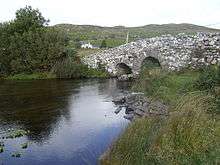
The story is set in the fictitious community of Inisfree. This is not the same as the Lake Isle of Innisfree, a place in Lough Gill on the Sligo–Leitrim border made famous by poet William Butler Yeats, which is a tiny island. Many scenes for the film were actually shot in and around the village of Cong, County Mayo, on the grounds of Cong's Ashford Castle. Cong is now a wealthy small town and the castle a 5-star luxury hotel. The connections with the film have led to the area becoming a tourist attraction. In 2008, a pub opened in the building used as the pub in the film (it had actually been a shop at the time when the movie was shot); the pub hosts daily re-runs of the film on DVD.[6] The Quiet Man Fan Club holds its annual general meeting in Ashford Castle. Other locations in the film include Thoor Ballylee, Co. Galway, home of poet W.B. Yeats for a period, Ballyglunin railway station near Tuam Co. Galway, which was filmed as Castletown station, and various places in Connemara Co. Galway and Co. Mayo. Among those are Lettergesh beach, where the horse race scene was filmed,[7] the Quiet Man Bridge, signposted off the N59 road between Maam Cross and Oughterard[8] and the "White O'Morn" cottage. The latter is located on R336 south of Maam, but has long ago fallen into ruin.[9]
The film also presents Ford's depiction of an idealized Irish society, with no social divisions based on class or religion. The Catholic priest, Father Lonergan, and the Protestant Rev. Playfair maintain a strong friendly relationship throughout the film – which represented the norm in what was then the Irish Free State. (Religious tensions occurred in the 1930s, but were the norm only in Northern Ireland.) The only allusions to Anglo-Irish animosity occur after the happy couple is married and a congratulatory toast expresses the wish that they live in "national freedom" (the term national has been censored from most editions)[7] and before the final donnybrook when Thornton demands his wife's dowry from Danaher. Danaher asks Hugh Forbes, who had been commander of the local Irish Republican Army unit during the fight to expel the British, "So the IRA is in this too, ah", to which Forbes replies, "If it were, not a scorched stone of your fine house would be standing."
Music
Ford chose his friend, Hollywood composer Victor Young, to compose the score for the film. Young sprinkled the soundtrack with many Irish airs such as the "Rakes of Mallow" and "The Wild Colonial Boy". One piece of music, chosen by Ford himself, is most prominent: the melody the "Isle of Innisfree", written not by Young, but by the Irish policeman/songwriter Richard Farrelly. The melody of the "Isle of Innisfree", which is first heard over the opening credit sequence with Ashford Castle in the background, becomes the principal musical theme of The Quiet Man. The melody is reprised at least eleven times throughout the film.
The upbeat melody comically hummed by Michaeleen Oge Flynn and later played on the accordion is the "Rakes of Mallow".
A portion of the Irish version of "The Wild Colonial Boy" is played throughout the film.
When Maureen O'Hara died in October 2015, her family stated she listened to music from The Quiet Man during her final hours.[10] Filmmaker George A. Romero was also said to have died listening to the score.[11]
Reception
A. H. Weiler of The New York Times called the film "as darlin' a picture as we've seen this year," with "dialogue that is as tuneful as a lark's song."[12] Variety called the picture "beautifully filmed" and wrote that "Wayne works well under Ford's direction," but found the 129-minute running time "unnecessary."[13] Harrison's Reports called the film "a delightful and rollicking comedy melodrama of Irish life, directed with skill and acted with gusto by a fine cast."[14] Richard L. Coe of The Washington Post called it "a complete jim-dandy ... The photography is glorious and Victor Young's score, inspired by folk airs, is a complete joy for an exuberant, vigorous picture."[15] Philip Hamburger of The New Yorker was not so taken with the film, writing, "If am to believe what I saw in John Ford's sentimental new film, 'The Quiet Man,' practically everybody in Ireland is just as cute as a button," adding, "Mr. Ford's scenes of the Irish countryside are often breathtaking ... but the master who made 'The Informer' appears to have fallen into a vat of treacle."[16]
The Quiet Man has a 90% approval rating on Rotten Tomatoes, with the critical consensus stated as, "Director John Ford and star John Wayne depart the Western for the Irish countryside, and the result is a beautifully photographed, often comedic romance."[17]
The film was also a financial success, grossing $3.8 million in its first year of release. This was among the top ten grosses of the year.[18] It was the seventh most popular film for British audiences in 1952.[19]
Academy Awards
| Award[20][21] | Person |
| Best Director | John Ford |
| Best Cinematography | Winton C. Hoch Archie Stout |
| Nominations | ||
| Best Picture | John Ford Merian C. Cooper | |
| Best Supporting Actor | Victor McLaglen | |
| Best Art Direction | Frank Hotaling John McCarthy Jr. Charles S. Thompson | |
| Best Sound | Daniel J. Bloomberg (Republic Sound Department) | |
| Best Adapted Screenplay | Frank S. Nugent | |
Home video
It was first released on DVD December 14, 1998 by Artisan Home Entertainment. It was also released 4 years later on a Collector's edition DVD on October 22, 2002 by Artisan. The Special features on this edition include "The Making of the Quiet Man" Documentary with Leonard Maltin, and "The Joy of Ireland" Documentary with Maureen O'Hara and Andrew V. McLaglen, and "Remembering The Quiet Man Montage".
On January 22, 2013 Olive Films released The Quiet Man on DVD and for the first time on Blu-ray, as a 60th Anniversary Special edition. It included the documentary "The Making of the Quiet Man" with Leonard Maltin.
In 2010 there was a documentary called Dreaming The Quiet Man made about the journey and making of The Quiet Man. It was narrated by Gabriel Byrne, and had interviews with Peter Bogdanovich, Martin Scorsese, Charles F. Fitzsimons, and Maureen O'Hara. It was released on DVD and Blu-ray for the first time on March 24, 2015.
See also
- John Wayne filmography
- Marquess of Queensberry rules of boxing
- Innisfree, a 1990 Spanish documentary film about the making of The Quiet Man
- Jaunting car, the horse-drawn vehicle owned by Michaeleen Oge Flynn that is first seen delivering Sean to Innisfree at the beginning of the film. Michaleen is seen using it throughout the film as his main mode of transport and it is in the amusing courting scenes that it plays a greater role.
Gallery
References
- ↑ "The Quiet Man - Details". AFI Catalog of Feature Films. Retrieved June 21, 2018.
- ↑ 'Top Box-Office Hits of 1952', Variety, January 7, 1953.
- ↑ "Library of Congress announces 2013 National Film Registry selections". Washington Post (Press release). December 18, 2013. Retrieved December 18, 2013.
- ↑ Maureen O'Hara with John Nicoletti. 'Tis Herself: An Autobiography, p. 158-159. Simon & Schuster Paperbacks (2005 edition).
- ↑ Maureen O'Hara with John Nicoletti. 'Tis Herself: An Autobiography, p. 169-170. Simon & Schuster Paperbacks (2005 edition).
- ↑ "Quiet Man fans can sup a stout in the film’s pub," Belfast Telegraph, August 25, 2008.
- 1 2 "The Quiet Man (1952) Trivia". IMDb. Retrieved August 12, 2017.
- ↑ "The Quiet Man Bridge". Oughterard Tourism. Retrieved 2017-08-12.
- ↑ "Day Two of the Quiet Man Celebration: I fell in love with the cottage at first sight ..I'll bring the dream alive and put back all that movie magic; White O'Morn Owner Vows to Restore It". The Mirror. Retrieved 2017-08-12.
- ↑ "Actress Maureen O'Hara dies at 95". USA Today. Associated Press (October 25, 2015)
- ↑ "George A. Romero, 'Night of the Living Dead' creator, dies at 77". LA Times (July 16, 2017)
- ↑ Weiler, A. H. (August 22, 1952). "The Screen In Review". The New York Times: 13.
- ↑ "The Quiet Man". Variety: 6. May 14, 1952.
- ↑ "'The Quiet Man' with John Wayne, Maureen O'Hara, Victor McLaglen and Barry Fitzgerald". Harrison's Reports: 79. May 17, 1952.
- ↑ Coe, Richard L. (October 3, 1952). "Now Irish Eyes Are Smiling Again": 30.
- ↑ Hamburger, Philip (August 23, 1952). "The Current Cinema". The New Yorker: 56–57.
- ↑ "The Quiet Man (1952)". Rotten Tomatoes. Retrieved January 29, 2017.
- ↑ Gallagher, Tag John Ford: The Man and his Films (University of California Press 1986) p.499
- ↑ "Comedian Tops Film Poll". The Sunday Herald. Sydney. December 28, 1952. p. 4. Retrieved August 12, 2017 – via National Library of Australia.
- ↑ "The 25th Academy Awards (1953) Nominees and Winners". oscars.org. Retrieved 2011-08-20.
- ↑ Crowther, Bosley (March 29, 1953). "The 'Oscar' Awards; Showmanship Rather Than Artistry Reigned at the Academy Affair". The New York Times. Retrieved 2017-08-12.
- Crosson, Seán and Rod Stoneman (2009). The Quiet Man ... and Beyond: Reflections on a Classic Film, John Ford, and Ireland. Liffey Press. ISBN 9781905785568. Includes chapters examining the film's use of language, style, landscape and Ford's connection more generally with Ireland.
- MacHale, Des (2004). Picture The Quiet Man. Appletree Press. ISBN 9780862819309. Includes an in-depth chapter on the film's score and the "Isle of Innisfree". No online access.
- McNee, Gerry (2012). In the Footsteps of the Quiet Man: The Inside Story of the Cult Film. Random House. ISBN 9781780574691. Narrative of the film's production.
External links
| Wikimedia Commons has media related to The Quiet Man. |
- The Quiet Man on IMDb
- The Quiet Man at the TCM Movie Database
- The Quiet Man at AllMovie
- The Quiet Man at the American Film Institute Catalog
- The Quiet Man on Rotten Tomatoes
- The Quiet Man at Filmsite.org
- Quiet Man Movie Club
- The Quiet Man at Reel Classics
- The Quiet Man Cottage museum in Cong
- William C. Dowling, "John Ford's Festive Comedy: Ireland Imagined in The Quiet Man"
- Dick Farrelly, songwriter: Lyrics
- A Quiet Man Miscellany Cork University Press
- Dick Farrelly and 'The Isle of Innisfree'
